Heart Rhythm
We can define heart rhythm as the succession of the heart beats. In the case of the electrocardiogram we would talk about the succession of the QRS complexes in the time that the recording lasts.
The heart rhythm is usually regular and with a heart rate within the normal range (between 60 bpm and 100 bpm), although certain diseases (read arrhythmias) may cause the heart rhythm to be irregular, too fast or too slow.
Regular Heart Rhythm
The first step in the heart rhythm analysis is to determine whether it is regular or not. To do so we must measure the distance between two consecutive R waves (RR interval). When the rhythm is regular this distance is similar between heart beats.
Usually we can determine whether the heart rhythm is regular or not by just looking at it, but when in doubt, we can use a compass or ruler.

Irregular heart rhythm
Normal Sinus Rhythm
Related article: How to recognize normal sinus rhythm
The sinus rhythm is the normal rhythm of the heart. It is produced by the sinus node, stimulating both atria, the AV node and from there to the ventricles through the bundle of His (read cardiac conduction system).
Conduction System of the Heart
- 1- Sinus stimulation, atrial depolarization (P wave)
- 2- Spread of electrical impulse through AV node (PR segment)
- 3- Ventricular depolarization (QRS)
- 4- Ventricular repolarization (T Wave)
To determine if an electrocardiogram represents a normal sinus rhythm, the following requirements must be met:
- Positive P wave in lead II and negative P wave in aVR.
- Each P wave must be followed by a QRS complex.
- The R-R interval must be constant.
- The PR interval must be equal to or greater than 0.12 s.
- Heart rate must be between 60 and 100 bpm.
In short, if the EKG represents a sinus P wave, always followed by a QRS complex, with normal PR interval and heart rate, it returns a report of sinus rhythm.
Related article: How to recognize normal sinus rhythm
Sinus Tachycardia and Sinus Bradycardia
When heart rate is greater than 100 bpm, we call it tachycardia. When heart rate is less than 60 bpm, we call it bradycardia.
Sinus Tachycardia
Sinus tachycardia does not usually stand for cardiac involvement, it occurs in healthy people with exercise. It also occurs as secondary to diseases requiring increased oxygen consumption, such as infections, shock or myocardial infarction.

Sinus tachycardia at 136 bpm
The EKG meets all requirements for sinus rhythm, except for the heart rate, which is greater than 100 bpm.
Sinus Bradycardia:
Sinus bradycardia does not always mean heart disease. It is common in athletes and patients with medication that slows the heart rates (beta-blockers, antiarrhythmic drugs)

Sinus bradycardia at 48 bpm
The EKG meets all requirements for sinus rhythm, except for the heart rate, which is less than 60 bpm.
When sinus bradycardia presents with very low heart rates or it is symptomatic (dizziness, syncope), with no medication to explain it, sick sinus syndrome or other bradyarrhythmias must be confirmed or ruled out.
Sinus Arrhythmia
Related article: Sinus arrhythmia.
Sinus arrhythmia is a sinus rhythm with variation of the P-P intervals that gradually and cyclically lengthen and shorten, related to the respiratory cycle.

Sinus arrhythmia:
Variation in P-P intervals related to the respiratory cycle.
It is usually asymptomatic and is a common finding in the electrocardiogram of children and young, healthy people.
Sinus arrhythmia is a normal physiological phenomenon and it is considered a variation of normal sinus rhythm.
More information: Sinus arrhythmia.
Arrhythmias
Arrhythmias are heart rhythm disorders that in most cases differ from sinus rhythm. We have a section dedicated to them, don’t forget to check it.
previous | next
If you Like it... Share it.










